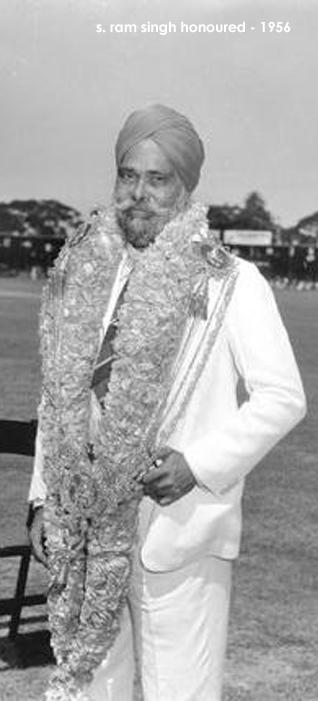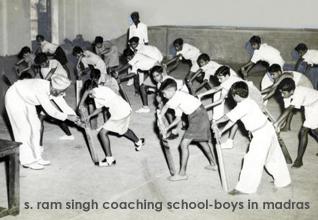Sports
The First Family of Cricket: The A.G. Singhs of Chennai-Madras
by NIKITA BASTIAN
Think iconic cricketers from Chennai (formerly, the City of Madras in South India) and your thoughts immediately drift towards the Srikkanths and Venkataraghavans.
But look much further back and you’ll find an unexpected family name running through the cricket lore of the Madras Presidency and, later, the Tamil Nadu state side: the “A.G.” Singhs, a family from Amritsar that migrated to Madras in 1904 and went on to be the first family of Tamil Nadu cricket for over six decades.
“It all began with my dad, A.G. Ram Singh, a first-class player and coach,” says 69-year-old A.G. Milkha Singh, a left-hand middle-order batsman who went on to represent India in four Tests between 1960 and 1961. “We picked up the finer points of the game from him. My granddad migrated to Madras to take up a job and my dad was born here, so this has always been home to us. We even added the initials A.G. to our names to give them a more Tamil feel!”
Milkha Singh, the fourth of Ram Singh’s five sons, started playing cricket at 13 and was the vice-captain of the All India Schools team that toured Sri Lanka in 1955. He was the top run-getter and wicket-taker in that tournament.
“Back then, we lived on Wallajah Road, so the stadium [M.A. Chidambaram] was just across the road from us. Dad used to pull me up by my ears and take me to practice,” Milkha chuckles.
Ram Singh retired from first-class cricket in 1945, with the distinction of being only the second cricketer and one of the quickest to reach that coveted double - 100 wickets and 1000 runs - in the Ranji Trophy. He was part of the Madras team that took on Mysore in the very first Ranji Trophy match, played in Chennai in 1934.
“My dad took 11 wickets in that game and it finished in one day instead of the stipulated duration of three days [Madras won by an innings and 23 runs]. In those days people had to go to the railway station to pick up the day’s newspaper, it was not door-delivered. When fans of the Mysore team went to pick up the paper that was to carry the report of the first day’s play, they were greeted by their team, alighting from the train!” laughs Milkha.
At that time there were few Tests and the Ranji Trophy was a knockout tournament, so cricketers did not get to play much during the year.
“And we were not paid anything. If we played, our bank account was minus Rs 100 at the end of the game, due to taxi fares.”
A job was a must for financial security and Milkha joined the State Bank of India in 1962, after playing one Test each against Australia and England and two against Pakistan.
Milkha’s oldest brother, the late A.G. Kripal Singh, a right-hand batsman and offspinner, also played Test cricket for India (14 Tests between 1955 and 1964, and scored an unbeaten 100 on debut against New Zealand in Hyderabad), while the youngest brother, Satwender Singh, played first-class cricket for Tamil Nadu.
When Kripal and Milkha played together for India against England in 1961-62, it was the first instance of three players from Tamil Nadu (the third being Vaman Kumar) being in the national playing XI.
“Kripal was a very good manipulator. He once even talked his way into having the Ranji Trophy final postponed so that he did not have to miss it to appear for his board exams!” laughs 64-year-old Satwender. “That was the first time Tamil Nadu [Madras] was in the final and we went on to win that game.”
Milkha adds, “When my elder brother and I batted together, we tricked the opposition into thinking that we found mediocre bowlers hard to manoeuvre. The idea was to smack the bowler for four once an over, but knowingly play and miss a couple of balls too, giving the opposition captain the false idea that the bowler could get us out. So he would keep him on and we kept getting our runs without much effort. We had a family code - if my brother thought it was time for me to go after the bowler, he would tell me to get four annas [Indian currency of the time, equivalent to pennies], that being our code for hitting a boundary.”
Playing alongside siblings was a lot of fun, if you go by the brothers’ accounts.
“When I was in class VII and Milkha in class XI, he was the captain of our school team and he drafted me into the team. Back then I didn’t wear a turban, and used to plait my hair. He got a lot of slack for letting a girl in the team,” grins Satwender.
The fun continues with the next generation, as is evident when their 41-year-old nephew, Arjan Kripal Singh, enters the conversation. “You guys play with full body armour,” Milkha tells Arjan, who retorts with a mischievous grin, “Bowlers used to apologise after bowling a bouncer in your time. What was the point of that?”
Arjan, Kripal’s son, was the last of the family to play first-class cricket - he twisted a knee just before a Ranji semi-final in 1996 and never played again - and with him ended the family’s remarkable record of having at least one representative at the state level for 62 years.
“My sister, Malvika Kaur, was in the Indian women’s team in the 70s, while my elder brother, Swaran Singh, also played first-class cricket in the late 80s,” says Arjan. “A cousin, Harjinder Singh, played Ranji Trophy, for the Railways and Tamil Nadu. In 1987 I was named vice-captain of the Indian Under-19 team for the inaugural Under-19 World Cup in New Zealand and Australia. Brian Lara, Michael Atherton, Mushtaq Ahmed and Narendra Hirwani [just after he took 16 wickets on Test debut] were all there.”
Arjan scored a triple-hundred in his second Ranji match.
“W.V. Raman also made 300 in that game, against Goa - the only instance of two triple-hundreds in the same innings - and we went on to have a record partnership and make a record total of 912. Arjan is captain of the Madras Cricket Club team and has just been appointed match referee by the BCCI."
Their adopted city took to “the only Sikh family in the world that can speak perfect Tamil” quite well.
“I remember I had to get a letter signed by the tahsildar to play for Tamil Nadu,” Satwender recounts. “He was very suspicious for obvious reasons - here was a turban-sporting sardar asking him to sanction him to play cricket for Tamil Nadu. But then his clerk told him, ‘This is Ram Singh’s son.’
That’s all it took. He seemed very pleased to do anything for me after that. That said a lot about how well-known and loved my dad was here.”
Milkha agrees. “In our time, league matches were huge,” he says. “The Marina ground gallery used to be full, and on the beach side you would find people standing behind parked cars to catch a glimpse of the action. A lot of these people flocked in to ‘see one of the sons of Ram Singh doing well’ and that felt special.”
The family praises the state’s cricket infrastructure, compared to that of the rest of the country.
“Tamil Nadu had a great cricket structure in place. It’s even better than Mumbai. It all started with a few interested individuals who encouraged cricketers back in the old days and offered them jobs, allowing them to pursue the game with a sense of security. Over the years it has blossomed and turned quite professional,” says Milkha.
Veteran journalist and cricket writer Partab Ramchand puts the "A.G. Singhs"’ contribution to Tamil Nadu cricket into perspective: “Ram Singh was the first great allrounder from Madras, a pioneer. He played two ‘unofficial Tests’ for India and dreamt of his three cricket-playing sons representing the country at the highest level. Only a knee injury [courtesy a scooter accident] kept Satwender Singh from following in his elder brothers’ footsteps in Test cricket. At that point Satwender was the best batsman in the state and would have made it to the national side but for that injury.
“After he retired, Ram Singh became a coach and father figure to big names like [Srinivas] Venkataraghavan. Through the generations, the A.G. Singhs have had a big impact on cricket in Tamil Nadu, no doubt.”
Milkha concludes our chat by telling us about a possession that is something of a family heirloom.
“Stop by our niece’s place and you’ll see a framed newspaper photograph of Satwender and me batting together for Tamil Nadu, in the Gopalan Troply in Sri Lanka, in the 60s. Tamil Nadu had lost a few wickets for a low score when my brother and I got together, and we batted the team out of trouble.
The piece is headlined ‘When the Sikhs go marching in,’” he adds, brimming with pride.
[Courtesy: Harjinder Singh Kukreja and ESPN. Edited for sikhchic.com]
January 10, 2012
Conversation about this article
1: Sanjeev (British Columbia, Canada), January 11, 2012, 10:02 AM.
Wonderful article.
2: Baldev Singh (Bradford, United Kingdom), January 11, 2012, 12:13 PM.
Every single activity Sikhs take up, they do better than anyone else!






